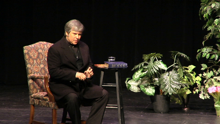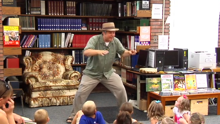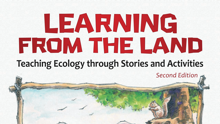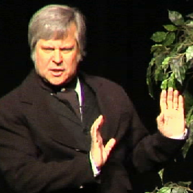By Brian “Fox” Ellis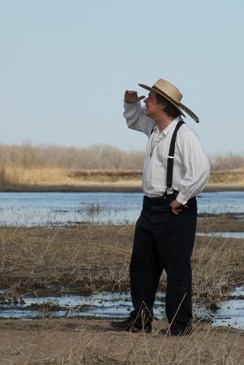
STEM Education might seem like the latest trend, but it is so much more than a passing fad. It has deep roots in the history of science education and innovation. If you have been teaching for more than a few years then you have seen fads come and go. With 35 years in science education, writing curriculum, teacher training, and portraying historical scientists, I have seen trends wax and wane, but STEM is different. STEM is a fresh encapsulation of what real scientists have done for generations. As we have evolved in the field of science education we have gotten better at defining what it is that real scientists do. STEM is a more broadly accurate explanation of science process skills. It is also forward thinking in its emphasis on training students to be ready for whatever new technology is around the bend, integrating math and science, and using engineering to focus on real world problem solving.
But one reason STEM is different is because none of these traits are new, they are simply articulated more clearly. Did you know: Charles Darwin made a technological improvement to the microscope that we still use today? Gregor Mendel was the first biologists to use statistical analysis in the natural sciences? John James Audubon engineered a method for painting birds and his great works of art used the latest technology in print making? Pick any innovative, ground breaking scientist and STEM is at the core of their work.
Share the stories of famous scientists with your students and you can give them an insider’s view of the scientific process. Every time you tell a story student’s are engaged in science process skills, collecting and analyzing data, making predictions about outcomes, and drawing their own conclusions. As student’s listen they are getting an over the shoulder view of using math, engineering, technology and science to solve exciting problems.
If our goal is to build a bridge to the future of STEM education then any good engineer will tell you that you must first build a solid foundation in the history of science. Storytelling is both the cornerstone and the strongest span in that bridge to the future.
Let’s start with the grandfather of modern biology, Charles Darwin. I could tell a dozen stories about Darwin, but two are most relevant to this conversation:
When Darwin was a young scientist the microscope was still a relatively new piece of technology. Without an electric light it was hard to see small specimens. Darwin made a minor adjustment that was a major innovation. He put a hole in the platform where the glass slide was mounted. He then mounted a mirror underneath so light could be reflected up through the glass slide making it much easier to study microscopic life forms. As technology evolved this mirror was replaced with an electric light, but the original idea of illuminating the specimen started with Darwin.
This very simple six sentence story can be told any time you use a microscope or any piece of lab equipment. It is a great example for students demonstrating how an important part of science education is tinkering and problem solving, engineering. This story can launch a brainstorming session on other ways we can make improvements to the technology we use everyday. Tell this story and then ask students to draw a model for improving whatever piece of equipment you use in the lab today.
What most amazes me about Darwin was his ability to synthesize an astounding amount of data to draw conclusions about the basic laws that govern nature. Long before computers and the internet, Darwin developed his personal world wide web of scientist with whom he traded more than 10,000 letters collecting data and trading ideas. (Many of these 10,000 letters are now available on-line at https://www.darwinproject.ac.uk) With new software and smart-phone apps scientist are increasingly turning to crowd-sourced data and citizen science projects. Darwin was doing this 160 years ago. One of his college buddies, Benjamin Dann Walsh, immigrated to Bishop Hill, the small town in Illinois where I now live. Walsh and Darwin traded at least 16 letters and Walsh sent Darwin boxes of insects with notes discussing variation and adaptation, two of the cornerstones of evolution.
Yes, it is fascinating to me that insects collected in my back yard were part of the discussion of evolution. Walsh was also the first American scientist to use his original research to affirm Darwin’s ideas about evolution at work in the prairies of Illinois. Walsh founded a magazine, The American Entomologist which is still in print. He was a pioneer in using beneficial insects in pest control. He was an early opponent of toxic pesticides.
Scroll down to the first sidebar to read one of my favorite stories about Darwin, Walsh, and beetles. Here is a link to an excerpt of a performance I gave as a part of Augustana College’s convocation series; the beetle story starts at 3:58: https://www.youtube.com/watch?v=LmNFScDcjCQ
Extending your journey down Darwin’s footsteps this story can be used as an introduction to one of several citizen science projects including:
- RiverWatch uses insects as indicator species of water quality. Here is the Link to the Mississippi Valley project, but many states & regions have their own program: http://www.ngrrec.org/Riverwatch/
- Journeys North which tracks animal migrations: https://www.learner.org/jnorth/
- And Back Yard Bark Beetles, which tracks invasive bark boring beetles: http://www.backyardbarkbeetles.org
This story of Darwin popping beetles into his mouth also exemplifies the importance of making those historical scientists more human. Sharing their foibles and failures might actually be as important as sharing their success as reported in a new study I found on NPR’s Hidden Brain program: http://www.npr.org/2016/06/07/481058613/how-the-stories-told-of-brilliant-scientists-affect-kids-interest-in-the-field
Gregor Mendel was a contemporary of Darwin and the two of them may have attended the same conference in Paris.
Gregor Mendel’s gift to biology was math. His mentor was a physics professor whose name we all know, Doppler, Christian Andreas Doppler. Though we all know the story of Mendel’s peas, I find it interesting that he kept detailed scientific records of the weather every single day of his adult life. That data has recently been used to affirm global warming in the Czech Republic. Though we think of Mendel as a biologist it was his undergraduate studies in physics that played an important role in his eventual studies of peas and heredity. Because of the intensive use of mathematics, statistics and graphing found in physics, it seemed logical to Mendel to use statistics and graphing in his studies of the inherited traits in peas. His discoveries of recessive and dominant traits, terms he coined, were ground-breaking in many ways, but equally amazing was Mendel’s use of math. Now common place, Mendel was the first to design an investigation in the natural sciences that used such a large study sample and then computed that data using statistics.
Scroll to the bottom of this page to read a short tellable tale that highlights Mendel’s immersion in math and physics. Ask students to come up with their own ways to model various scientific ideas using every day items, like trumpets. The attached story is an excerpt from my upcoming book on Mendel’s life and work.
To follow in Mendel’s footsteps in Phenology, the collecting of every day details about weather and other natural phenomenon here is another great citizen science web site:
https://www.usanpn.org/natures_notebook
Rather than read aloud or watch a video with your class, I encourage you to read the story a few times to yourself and then stand up and tell the story. You could do it first person, as I do. Or, if that feels uncomfortable to you, just change the pronouns and tell the story about your favorite scientist. When you tell the story you are getting immediate feedback from the students about which parts they understand and where you may have to further explicate a complex concept. Watch them watch the story and you will know if they are with you or if you need to adapt. You can adapt the language to fit your grade level. you can lengthen or shorten the story as needed. Storytelling has much more immediacy. It is a more visceral experience for both the teller and the listener.
One of my favorite scientists, and a great storyteller, is John James Audubon. Most know him as an artist. He was the first to paint every known bird in North America and his art graces the walls of countless art and science museums around the world. Less widely known is the fact that he wrote a seven volume book on the Birds of North America with more than 2000 pages of field notes, observations on bird behavior, and detailed experiments he conducted on many species. There are field sketches and diagrams of dissections, exploring habitat and internal anatomy. He also traded letters with other ornithologists and was a pioneer in citizen science data collection. And he was innovative in using the latest print making technology. He was the first to band a bird, proving that they migrate and that they return to the same nests, what we now call site fidelity.
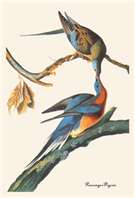
In one story: John James Audubon tells of a flock of passenger pigeons that blackened the sky for three days. He knows he cannot count that many birds, so he imagines a grid upon the sky. He counts how many birds in each square, 4, then multiplies the number of rows, times the number of columns, times the number of birds in each square. He then clocks how long it takes for one bird to fly from horizon to horizon, about a quarter hour. Four skies filled with birds per hour times 72 hours! An estimated 1.2 billion birds in one flock. This simple story introduces the importance of math in relation to field biology. This technique of using a grid superimposed on a large group can be adapted to count flocks of birds, clouds of gnats and schools of fish.
Follow this link for Audubon’s story about the Ruby Throated Hummingbird and a lesson plan on Rewriting Audubon’s bird essays, integrating modern science with his over-the-top romantic flourishes. Here is a video of my tour of an Audubon art gallery with a few other bird tales.
Any one of the stories in Audubon’s Ornithological Biography could be used as an example of creative non-fiction, romantic true stories about the lives of birds. These stories will inspire students to conduct their own field study of a favorite bird. These stories can be a model for writing their own essays. Audubon’s work has inspired countless ornithologists and could be a springboard for more citizen science projects including:
- The Great Backyard Bird Count - http://gbbc.birdcount.org
- Feeder Watch - http://feederwatch.org
- Christmas Bird Count - http://www.audubon.org/conservation/join-christmas-bird-count
As the old aphorism goes, “We are all standing on the shoulders of Giants”. By telling the stories of historical scientists, seeing their struggles and engaging in STEM, we can inspire and instruct students to motivate real inquiry. Through on-line citizen science programs we allow our students to participate in ground breaking research, not just the pretend replication of experiments that I remember doing in science class as a child, but actual global studies of water quality, invasive species distribution, and bird migration patterns.
Here are several more hubs for citizen science projects your students will enjoy:
- http://www.scientificamerican.com/citizen-science/
- http://nationalgeographic.org/idea/citizen-science-projects/
- http://www.birds.cornell.edu/citscitoolkit/projects
- http://www.citizensciencealliance.org/index.html
And a final thought on building, STEAM: when we add Art to STEM, it becomes STEAM. When we tell the stories of great scientists, warts and all, we motivate creativity, we provide working models of how science works, we engage students in a more open-minded inquiry process as they make predictions about potential outcomes, we show them that science is messy, fun, filled with missteps, but if we persevere it is always worth the journey! Will you help build this bridge and lead your students into the future with STEAM?
DARWIN TELLS HIS STORY:
Where do I begin? With questions, of course! Questions are the foundation of all good science!
I spent my life trying to answer the big questions, the mystery of mysteries… Did creation happen just once? Or is the story of creation forever and always unfolding? Consider all of the creatures upon the earth today; were they all here since the dawn of time? Or do you believe that new species evolve from the old? If you believe as I do, how is it that new species are formed? What are the mechanisms by which species adapt to changes in the world around them?
In the struggle for survival, what governs the success of some and the extinction of others? What are the laws of nature that shape life upon this planet?
These are the questions I sought to answer and shall answer for you if you dare to ask.
My curiosity began as a young man. I was always wandering in the forest and fields of my Uncle Josiah Wedgewood’s estate, collecting insects and stones.
My research began when I was yet in college, at Edinburgh, Scotland, where I began to collect beetles in earnest. No poet ever felt more delighted at seeing his first poem published than I did at seeing my first beetle identified in Stephens' Illustrations of British Insects; under the illustration were the magic words, ‘captured by C. Darwin, Esq.”
I will not soon forget one afternoon in particular.
As I was walking along, I came upon a tree where some bark was pealing loose. There I spied a beetle. Without a net or collecting jar, I snatched it up in my hand. In almost the same moment I spied a second, distinctive beetle and snatched it up into my other hand. Soon after, under the edge of the bark, I saw a third unique species of beetle. What was I to do? Two hands, three beetles, I popped one beetle into my mouth to free up a hand. In that same instant the beetle squirted an acrid fluid into my mouth. My tongue, lips and the inside of my cheeks burned with this acidic fluid. What would you do? Exactly what the beetle would want you to do. You would spit out the beetle, as did I. The third beetle, the one I was about to scoop up also escaped.
I had to pause, and wonder… How could there be three varieties of beetles under this one piece of bark? Clearly, all three were insects, with their six legs and hard shiny, exoskeleton, but such variety in one small place? Each had adapted to different foods: One had pinchers for eating leaves, one had a snout for sucking sap, and one had larger pinchers for eating other beetles, an herbivore, a parasite and a carnivore. Over time, these species had changed to survive, inheriting traits from their ancestors, but what mechanism selected these species to thrive here?
Excerpted from Charles Darwin and His Revolutionary Idea. Ellis, Brian “Fox” Fox Tales International, 2008. Illustrated by Peter Olson. Used with permission.
MENDEL TELLS HIS STORY: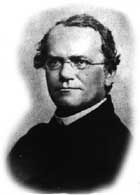
From my father I learned to work hard to reach my goals. From my family I learned the importance of sacrifice. It was through the struggles of my youth that I learned the patience and persistence I would need to succeed, AND it was through the wisdom and sense of purpose I learned in the monastery that I was able to begin to ask the deeper questions.
Why is it that some sheep give more wool? Why do some bees make more honey? Why do some split peas make a better soup, while other peas are plumper and taste sweeter when steamed with potatoes? These are the questions of a simple farmer, but asking these questions led me to the threshold of knowledge, the first step towards wisdom.
The Emperor encouraged the church to educate the youth. The Abbot encouraged me to learn. The Bishop ordered me to teach. And God ordained me, provided me with all I needed so I could unlock the gates of wisdom.
Father Napp, the Abbot, encouraged all of us to follow our calling and he had the clout to open doors for us. He brought to our humble monastery some of the leading minds of Eastern Europe and traded correspondence with some of the greatest thinkers of our day. As I already said, Father Napp breed sheep; not to improve sheep, but to improve the lives of the local peasants. Moravia grew fine wool and our town, Bruno was a major producer of textiles. St. Thomas monastery was not a rural run down cloister, though it was built in 1322, it was the intellectual and spiritual heart of our community.
In order for me to teach, I needed to go to Vienna for my teaching exam. Maybe because I only had a year of teaching and no university training, Maybe it was my fear of failure and the anxiety I felt about test taking, I failed my examination and returned to St. Thomas, dejected. Teaching was my vocation and the university said I was unfit.
But in failure there is opportunity. Yes, in failure there is opportunity.
If the university board said I needed further education to teach, then Father Napp would support my education at the university. He sent me back to Vienna. Imagine a farmer’s son in the cultural capital of Europe. My professors were some of the most famous scientists of our day. I arrived a month late for classes, had trouble finding a place to live, and instead of the standard 20 lectures a week I took in 32 to try to make up for lost years!
Have you heard of the Doppler effect? Well, the great physics professor Doppler, was not only my teacher, but I soon became his demonstrator. I think you would say ‘graduate assistant.’ I wish I was so wise, but another professor, Ballet, came up with an idea for demonstrating his Doppler Effect. He had all of the students stand on the platform of the train station. Then at his command an open train car in the distance was filled with twenty trumpet players, all playing the same note. As the train came speeding past everyone heard the note rise and fall in pitch, we perceive the change in frequency of the sound wave because of movement, even though the sound wave, the pitch, stayed the same. The Doppler Effect.
Doppler soon retired and Andreas von Ettinghausen taught physics. He is best known for his combination theory, it is a mathematical way of determining the relationships between what might appear to be random groups of things. Look around the room now; even though each of you chose to sit randomly, there is a pattern. Some of you choose to sit near the front, you are teacher pleasers, most eager to learn! Many of you sat near the back or aisle so you could slip out early if I am boring you. Ettinghausen was an inspiration. His number theories have become very important in many branches of science. They were also very important in my work with peas as you will soon see.
His combination theory was a part of the avalanche of numbers. The scientific community was looking for answers. Mathematics, ratios, relationships, statistics were one way of finding those answers.
